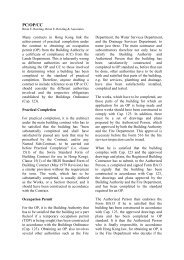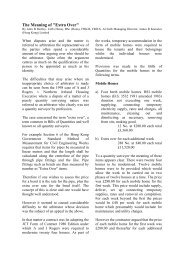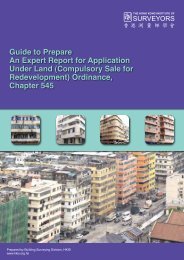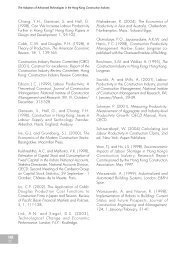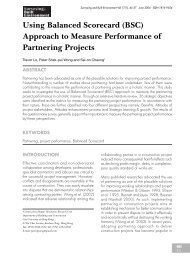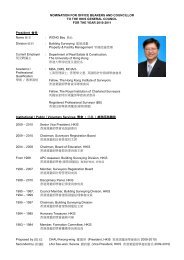Surveying & Built Environment Vol. 22 Issue 1 (December 2012)
Surveying & Built Environment Vol. 22 Issue 1 (December 2012)
Surveying & Built Environment Vol. 22 Issue 1 (December 2012)
Create successful ePaper yourself
Turn your PDF publications into a flip-book with our unique Google optimized e-Paper software.
ii) After the use of building for a period<br />
of time (assuming a standard period of<br />
15 years), emissions resulting from the<br />
large-scale update of building including<br />
full inside and outside decoration, can<br />
be calculated through Equation (5).<br />
Emissions 5i'' = (emission i of fitting-out<br />
works outside the building + household<br />
renovation) × 100% (5)<br />
Therefore, emission quantity for<br />
building maintenance and repair will<br />
be the sum of emissions due to the two<br />
aspects above and can be calculated<br />
through Equation (6).<br />
Emissions 5i = Emissions 5i'+<br />
Emissions 5i''<br />
<strong>Surveying</strong> and <strong>Built</strong> <strong>Environment</strong> <strong>Vol</strong> <strong>22</strong>, 61-73 Nov <strong>2012</strong> ISSN 1816-9554<br />
(6)<br />
Demolition period<br />
Similar to the analysis in the previous<br />
part, there is a precise and a forecasting<br />
calculation method to calculate<br />
emissions resulting from building<br />
demolition.<br />
(a) Method for precise calculation<br />
Precise calculation method is applicable<br />
when the building has been demolished,<br />
thus the total consumed energy data can<br />
be collected. The calculation method<br />
shown in Equation (2) but replacing j<br />
as one type of fuel and Q j as the amount<br />
of fuel j consumed by various kinds of<br />
devices or electricity use (kWh).<br />
(b) Method for forecasting calculation<br />
The forecasting calculation method<br />
is applicable when the building has<br />
not been demolished and the energy<br />
consumption data is unknown. The<br />
emission quantity can be estimated<br />
by using the total building floor area<br />
and units for floor removal data. The<br />
calculation can be conducted by using<br />
Equation (7).<br />
Emission 6i = the total building floor<br />
area × emission units for floor<br />
removal (7)<br />
Disposal of construction waste<br />
Emissions generated for waste disposal<br />
are due mainly to transportation, which<br />
will induce fuel combustion and dust<br />
abatement measures. The emission can<br />
be calculated through Equation (8).<br />
Emission 7i = D x FR × EF ij<br />
(8)<br />
where i (i = 1, …, 8) is one of the<br />
emissions, such as CO 2, CH 4, N 2O, SO 2,<br />
CO, NO X, NMVOC and particulates;<br />
Emission 7i the quantity of emission i<br />
in this period (g); D the total transport<br />
distance (km); FR the fuel rate of<br />
conveyance (kWh/km); D x FR the<br />
amount of fuel burned (kWh); and<br />
EF ij the emission factor of emission i<br />
generated by fuel j combustion (kg/<br />
kWh).<br />
Calculation model for total gaseous<br />
emissions during building life cycle<br />
Based on the analysis above, the total<br />
amount of eight gaseous emissions<br />
during construction project life cycle<br />
can be calculated through Equation (9).<br />
Emissions = Emissions ki (9)<br />
where k (k = 1, …, 7) is a specific<br />
element of the building life cycle,<br />
including manufacturing of building<br />
materials, building materials<br />
transportation, construction, operation,<br />
maintenance and repair works,<br />
demolition, waste disposal; i (i =<br />
1, …, 8) for each of the emissions,<br />
such as CO 2, CH 4, N 2O, SO 2, CO,<br />
NO X, NMVOC and particulates; and<br />
Emissions ki the amount of gaseous<br />
emission i during period k.<br />
SBE<br />
69




